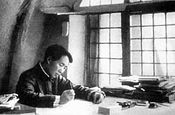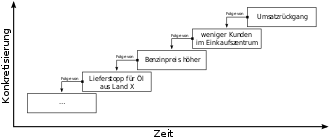Contradiction theory
Contradiction theory is the western term for a scheme developed by Mao Zedong , which serves to simplify the materialistic dialectic for political practice.
It is based on Georg Hegel's thesis of contradiction , which assumes that there is also a contradiction d. H. there is a situation that is contrary to this. This creates a convergence to the model of yin and yang of classical Chinese philosophy , and it is precisely this parallel that characterizes Mao's way of thinking.
In contradiction theory, however, the term contradiction is also used as a synonym for a process or the dialectical three-step thesis → antithesis → synthesis . As a result, Mao's article on contradiction, in which he explains the theory of contradiction for the first time, can hardly be understood without this prior knowledge.
development
Máo Zédōng became the political leader of the CCP as a result of the long march . The party successfully established a base in Yan'an in 1936 and took control of the northern part of Shaanxi Province .
The defeats caused by the Shanghai massacre and the Nanchang uprising against Chiang Kai-shek clearly showed that it was impossible to use the CPSU's program as a template in China. This and the break between the communists and the Kuomintang led to the reorganization of the CCP and the development of an independent ideology adapted to Chinese conditions : Maoism .
As a concretization of the materialist dialectic, the theory of contradiction takes the position of the philosophical basis of Maoism . Although the CCP reoriented itself programmatically under Deng Xiaoping , it has retained Mao Zedong's method of dialectic in its function as an epistemology to this day.
For this reason, it is recommended by political science to understand the domestic political situation in the People's Republic of China to study contradiction theory, as well as Mao Zedong's articles on contradiction and on practice .
Dialectic in Mao
| thesis | Antithesis |
|---|---|
| male warm matter expansion socialist movement arm active craft |
female cold antimatter contraction conservative standstill empire passive industry |
Máo regards contradiction as synonymous with polarity , relation and property . There is also a contradiction to each issue d. H. an opposite of this fact. These two facts are considered a thesis and an antithesis, each of which interacts in a process.
As with Marx and Engels, with Mao too dialectics is linked to materialism . His worldview is purely atheistic and deterministic : only scientific facts are to be placed in the function of thesis and antithesis . The universe is the sum of deterministic movement processes of matter , whereby any interference of a higher being is excluded.
He extends the Marxist dialectic to include the following terms:
- 阶段, jiēduàn - stage
- 根本矛盾, gēnběn máodùn - basic contradiction
- 主要矛盾, zhǔyào máodùn - primary contradiction
- 次要 矛盾, cìyào máodùn - secondary contradiction
- 次要 矛 主, cìyào máochan - tertiary contradiction
阶段 / stage
A process, i.e. the dialectical three-way cut thesis → antithesis → synthesis , takes place within a certain time window . This time window can logically be of any size - for example, political processes can last years, decades or even just a few hours.
Mao divides these time windows and describes the respective sections as a stage. Although the stages can be interpreted in any chronological order, he arranges the stages according to the progress of the process. For example, if you look at the development process from a seed to a plant , the seedling stage is just one stage in the entire process.
根本矛盾 / basic contradiction
As a basic contradiction, Mao describes the cause, or the trigger of a causal chain . The fundamental contradiction therefore occupies a dominant position, although the processes within the causal chain as well as different stages of an individual process differ qualitatively. He describes it as follows:
“The basic contradiction in the development process of a thing and the essence of the process conditioned by this basic contradiction do not disappear as long as the process is not completed; but the circumstances in the individual stages of this long development process often differ. This results from the fact that the fundamental contradiction in the development process of the thing in question, although its character and the essence of this process do not change, takes on ever sharper forms in the individual development stages of the long process. What is more, among the larger and smaller contradictions that are conditioned by the basic contradiction or are under its influence, some are exacerbated, while others are temporarily or partially resolved or alleviated and yet other, new contradictions arise. This is why the process occurs in stages. Whoever does not pay attention to the stages of the development process of a thing is not in a position to handle the contradictions inherent in the thing in an appropriate way. "
主要矛盾 / primary contradiction and 次要 矛盾 / secondary contradiction
In contradiction theory , the term contradiction is used as a synonym for a process, or the dialectical three-way cut thesis → antithesis → synthesis . Máo therefore sees the primary contradiction as a process on which other processes depend. These dependent processes are called secondary contradictions.
Mao also describes this relationship by referring to the primary contradiction as a combination of secondary contradictions ( Chinese:次要 矛盾 方面, cìyào máodùn fāngmiàn ).
- example
“ A process takes place in a steam engine that creates a mechanical movement . This mechanical movement is transmitted to five looms with the help of shafts , which triggers their working process. The working process of the steam engine takes the position of the primary contradiction, the working processes of the five looms the position of secondary contradictions. "
“If one of the looms fails due to a defect, the other processes remain unaffected. However, if the steam engine fails, all six active processes come to a standstill. "
application
For the Maoism the connection of materialist dialectics with is pragmatism and elements of classical Chinese philosophy characteristic.
Mao Zedong is strong through Sunzi's theorem
“The general who wins a battle makes many mental calculations before the battle. The general who loses makes hardly any calculations beforehand. So many calculations lead to victory and few calculations lead to defeat - none at all! By paying attention to this point, I can predict who will win or lose. "
embossed.
The contradiction theory is used to structure processes and events by classifying them in a causal chain . With the help of this structuring, the user should be able to use the knowledge about the previous and the expected further course of the causal chain in order to make appropriate decisions. In this context, contradiction theory is quite useful.
The scheme can also be used as a method for brainstorming through the use of tools such as meta cards and flipcharts and joint implementation in a group .
Since contradiction theory can be applied independently of Marxism , it has taken on a life of its own in the People's Republic of China and is sometimes even used by the materialist wing of the New Confucians .
literature
- Mao Zedong : About the contradiction , Berlin: Dietz 1954. Online version at marxists.org
- Mao Zedong : Selected Writings; Vol. 1 Dietz, Berlin 1956.
- Mao Zedong : Four Philosophical Monographs . Dietz, Berlin 1965.
- Ingo Schäfer: Mao Tse-tung. An introduction to his thinking . CH Beck, Munich 1978. ISBN 3-406-06784-0 .

